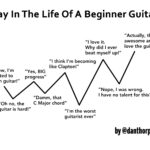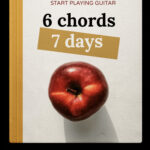The E minor 7th chord, or Em7, is a staple for guitarists seeking to add depth and emotion to their playing. Comprised of the notes E, G, B, and D, this chord’s minor tonality combined with the 7th interval creates a sound that is both melancholic and beautiful. Fortunately for aspiring guitar players, Em7 is quite accessible in open position, offering several variations that are easy to learn without sacrificing sonic quality. Let’s explore different ways to play the Em7 chord and see how these voicings are used effectively in popular music.
The Simplicity and Depth of the Basic Em7
Perhaps the most straightforward way to play an Em7 chord in open position builds upon the familiar E minor chord shape. This version requires fretting just one note, allowing all six strings to ring out, producing a full and resonant sound. You can quickly learn this Em7 formation here.
- Middle finger: 2nd fret of the A (5th) string
Alt text: Simple Em7 guitar chord diagram, middle finger on 2nd fret A string, played on all six strings.
Strumming all six strings from the low E string downwards will produce the notes E, B, D, G, B, and E, from lowest to highest. This voicing delivers a deep and fundamental Em7 sound.
This fundamental Em7 voicing finds its perfect place in Marvin Gaye’s timeless hit, “Let’s Get It On.” The song’s chord progression is intentionally repetitive and simple, creating a groove that is both consistent and deeply sensual. This simplicity allows other elements – Gaye’s soulful vocals, the signature wah-wah guitar, lush horns, and subtle drums – to truly shine. The Em7 in “Let’s Get It On” provides a rich harmonic foundation that underpins the song’s emotive power. Mastering this Em7 position is a quick way to unlock classic songs and begin to appreciate the subtle power of chord voicings.
A Higher and More Delicate Em7 Voicing
For a brighter, more delicate flavor of the Em7 chord, another open position variation exists. This voicing omits the lower E and A strings, resulting in a higher register and lighter texture. Discover this higher Em7 position in this lesson.
To achieve this Em7, position your pinky and ring fingers on the 3rd fret of the high E and B strings, respectively. Your middle finger then reaches to the 2nd fret of the D string.
- Middle finger: 2nd fret of the D (4th) string
- Ring finger: 3rd fret of the B (2nd) string
- Pinky finger: 3rd fret of the E (1st) string
Alt text: Higher Em7 guitar chord diagram, middle finger 2nd fret D string, ring finger 3rd fret B string, pinky finger 3rd fret high E string, strummed from D string.
Strumming downwards from the D string across four strings will produce this brighter Em7.
This higher Em7 voicing is perfectly showcased in the bridge of “Say Yes” by Elliott Smith. Featured on his 1997 album Either/Or and in the Good Will Hunting soundtrack, “Say Yes” exemplifies Smith’s intricate songwriting and delicate guitar work.
The bridge section of “Say Yes,” with lines like “Crooked spin can’t come to rest. I’m damaged bad, at best,” highlights the beauty of this Em7 voicing. Smith’s guitar work in this section involves quick transitions between complex chords, made smoother by the efficient finger placement of this Em7. The pinky and ring fingers remain anchored, allowing the index finger to navigate the bass notes during chord changes. This bridge builds to the song’s core message, “They want you or they don’t. Say yes,” and the nuanced Em7 voicing contributes significantly to the emotional depth and harmonic interest of this poignant song.
Combining Fullness and Complexity with the 6-String Em7
For guitarists seeking a rich and complex Em7 sound that encompasses the full range of the guitar, a 6-string open position voicing combines elements of the previous two. This formation requires a slightly greater finger stretch but yields a full and harmonically rich result. Explore the full 6-string Em7 position in this lesson.
- Index finger: 2nd fret of the A (5th) string
- Middle finger: 2nd fret of the D (4th) string
- Ring finger: 3rd fret of the B (2nd) string
- Pinky finger: 3rd fret of the E (1st) string
Alt text: Full 6-string Em7 guitar chord diagram, index finger 2nd fret A string, middle finger 2nd fret D string, ring finger 3rd fret B string, pinky finger 3rd fret high E string, strummed on all six strings.
Strumming all six strings for this version creates a powerful and complete Em7 chord.
The nuances of different chord voicings become clearer with experience. Listening to the 6-string Em7, it’s evident why Oasis chose this voicing for “Live Forever.” It appears at the start of the chorus with the lyric “Maybe I just wanna fly,” and the fullness of this Em7 complements Oasis’s characteristic use of expanded chords. Recognizing these patterns is part of developing musicality; musicians often cultivate signature sounds through chord choices and voicings.
To deepen your understanding of chords, explore Fender Play’s comprehensive chord library, learn about various chord types, and find helpful tips for mastering them.
Ready to shape your own signature sound? Begin your free trial of Fender Play today to discover more chords like the Em7 and to play songs that inspire your musical journey!


